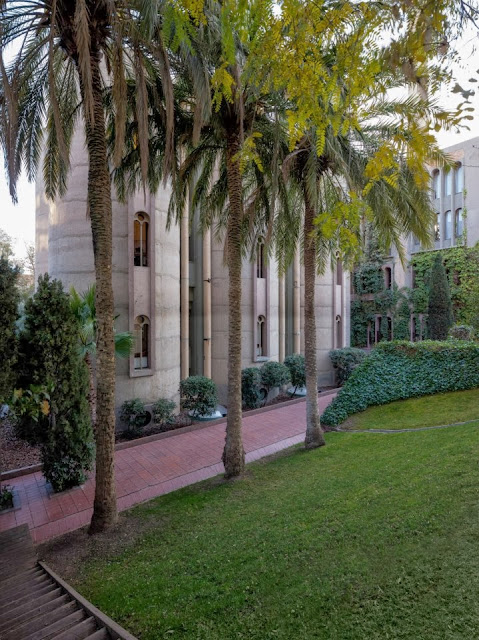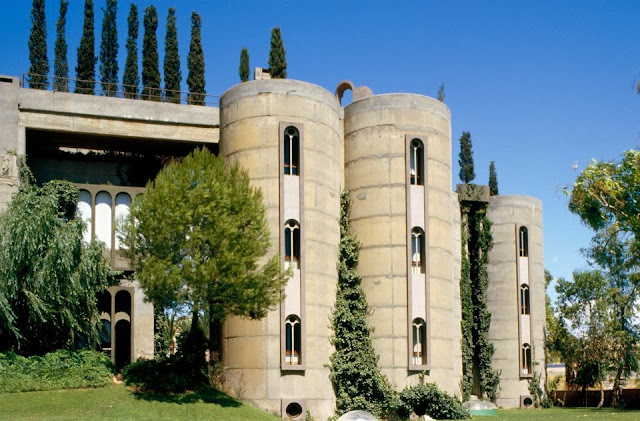THE CEMENT FACTORY DESIGN BY RICARDO BOFILL
THE CEMENT FACTORY DESIGN BY RICARDO BOFILL
The Cement Factory was discovered in 1973, it was an abandoned cement factory and partially in ruins, comprised of over 30 silos, underground galleries and huge engine rooms; Ricardo Bofill bought it and began renovation works. He identified the program; The Cement Factory was to be used as architectural offices, archives, a model laboratory, and exhibition space, an apartment for him, as well as guest rooms and gardens. He defined the space by demolishing certain structures, cleaning cement, exposing previously concealed structures and creating the landscape architecture by planting various plants such as eucalyptus, palms, olive trees and cypresses; renovation works lasted nearly two years.
Bofill imagined the future spaces and created a layout according to the different aesthetic and plastic predispositions that had developed since WWI and were present within the factory. A compendium of surrealist elements; paradoxical stairs that climbed to nowhere, the absurdity of certain elements that hung over voids, compelling but useless spaces of strange proportion but magical because of their tension and disproportion. Elements of abstraction; pure volumes which reveal themselves at times broken and impure as well as elements of brutalism; abrupt treatment and sculptural qualities of the materials. Being seduced by the elements of contradiction and the vagueness of the space he decided to preserve the factory and modify the original brutality (due to the coarse of nature and the former program), and sculpt it like a work of art. All these magical elements stand in the midst of transformed gardens which were once the yard of a cement factory.
Various spaces came into view, and the structures were given a use; their characteristics are what assigned their new program: the cathedral, the garden, and the silos. The renovated construction incorporates various languages from history of Architecture, a cultured language in opposition to vernacular architecture with windows, doors, stairs and false perspectives and applied them to the exterior walls and some interiors. Slowly with the help of Catalan craftsmen the factory was transformed but will always remain as unfinished work.
The abundant space and the height provided demonstrate inconceivable moderation; the interior space has not been crammed up with too many decorative elements; rather the interiors are deliberately appointed with casual contemporary elements. Carefully casual slip-covered white sofas, white canvas sling-back seating, tobacco colored leather sofas, large monochromatic rugs with no reference of detailing, the inconceivably tall curtains and many more elements add to the lofty style of The Cement Factory. The office area features spectacularly lengthy conference tables paired with leather seating and beautifully framed architectural prints which hang on the walls or are displayed on wooden easels.
Ricardo Bofill currently lives and works in The Cement Factory better than anywhere else, it is the only place where he can concentrate, associate ideas in the most abstract manner, and finally creates projects, and constitutes a specific vocabulary for his architecture.
“to be an architect means to understand space, to understand space organized by man, to decipher the spontaneous movements and behavior of people, and to detect the needs of change that they might unconsciously express. It is essential to track down these issues if we want to contribute with our personal work to the history of architecture.” Ricardo Bofill
Overall, The Cement Factory is a building with unique design and architectural elements; a lofty interior full of style. A mixture of textures and forms, materials and impressions; the enormous spaces, the large arched windows and the stunning quality of natural light throughout the day makes it a unique place to live in and work in. Moreover, these magical elements stand in the midst of transformed gardens which were once the yard of an abandoned cement factory
The abundant space and the height provided demonstrate inconceivable moderation; the interior space has not been crammed up with too many decorative elements; rather the interiors are deliberately appointed with casual contemporary elements. Carefully casual slip-covered white sofas, white canvas sling-back seating, tobacco colored leather sofas, large monochromatic rugs with no reference of detailing, the inconceivably tall curtains and many more elements add to the lofty style of The Cement Factory. The office area features spectacularly lengthy conference tables paired with leather seating and beautifully framed architectural prints which hang on the walls or are displayed on wooden easels.
Ricardo Bofill currently lives and works in The Cement Factory better than anywhere else, it is the only place where he can concentrate, associate ideas in the most abstract manner, and finally creates projects, and constitutes a specific vocabulary for his architecture.
“to be an architect means to understand space, to understand space organized by man, to decipher the spontaneous movements and behavior of people, and to detect the needs of change that they might unconsciously express. It is essential to track down these issues if we want to contribute with our personal work to the history of architecture.” Ricardo Bofill
Overall, The Cement Factory is a building with unique design and architectural elements; a lofty interior full of style. A mixture of textures and forms, materials and impressions; the enormous spaces, the large arched windows and the stunning quality of natural light throughout the day makes it a unique place to live in and work in. Moreover, these magical elements stand in the midst of transformed gardens which were once the yard of an abandoned cement factory
RICARDO E. BOFILL MAGGIORA
Ricardo E. Bofill
started at RBTA in 1992 as a model– maker summer–intern, was assistant at the
Rice summer Institute at the Taller, was later assistant Commercial Officer,
assistant Chief Architect, Chief Architect, was Head of RBTA China, Head of
India, before becoming President of the Company in 2012.
Ricardo focuses on
large–scale international urban projects, in which he resolves progressive
housing, mobility issues, ecology, as well as master planning for mega-cities.
He received his B.A in Architecture at Rice University, M. Archi at Harvard
University, M.A in Real Estate Development at Columbia University and Dipl in
Film Studies at UCLA. Ricardo has published 3 fictional novels (“Perséfone” in
1995, “Bajo mi Piel” in 1997 and “Yo no trago” en 2003) and directed the films
“Hot Milk” in 2003
and “Nietzsche” in
2010.
KEY PROJECTS
Dallas Trinity and
Downtown The Connected City. 2013, USA
Metropolis Village.
2013, Chennai, India
Great Moscow. 2012,
Moscow, Russia
Novoorlovskiy. 2012,
St. Petersburg, Russia
Signature III. 2011,
New Delhi, India
Smolniy. 2011, St.
Petersburg, Russia
W Hotel Barcelona.
2009, Barcelona Spain
Supeshine
Residences. 2004, Beijing, China
Shangri- La Hotel
and Residenes. 2004, Beijing, China
Casa Ananda. 2004,
Miami, USA
National Theatre of
Catalonia. 1997, Barcelona, Spain
www.biennale.ricardobofill.com
B
RICARDO BOFILL
Ricardo Bofill, born in 1939 in
Barcelona, graduated from the Barcelona University School of Architecture and
the School of Geneva. In 1963 he gathered a multidisciplinary,
multitalented group in order to confront the complexity of architectural practice;
architects, engineers, planners, sociologist, writers, movie makers and
philosophers, conformed what is known today as the Taller de Arquitectura.
In Bofill’s work, History has been a
constant presence, not only in the form of the continuing analysis and
interpretation of the culture and architecture of the past, but also by means
of the impetus given to new tendencies, to involvement in the social movements
of the day and the creation of alternative responses to contemporary problems.
The professional progress of the Taller de Arquitectura, marked by the stimulus
and the conception of life, the vital vision of an inexhaustible Ricardo
Bofill, has undergone a series of practical and theoretical changes closely
linked to the political and social transformations of recent years. An analysis
of the body of Bofill’s work as a whole reveals a tremendous degree of
coherence and a continuity of thinking that are the product of a history and a
language that are uniquely personal.
In his first period, Bofill recuperated
the characteristic craft elements of traditional Catalan architecture. Later
on, he began to deal with urban planning problems at a local level within the
Spanish political and social context. Because of the necessity to approach
major projects, Bofill’s team conceived a methodology based on the geometric
formation of elements in space, developed in a theoretical manner with the
project The City in Space, and made it concrete with the construction of Walden
7.
Interested in the urban planning problems
of the developing countries, Bofill transported a part of his team to Algeria
where he collaborated with the government in the urban planning and housing
field. His work culminated two years later with the construction of Houari
Boumédienne Agricultural Village in the south-eastern part of the country.
In 1971 he formed a complementary team in
Paris, in response to the demands of various projects for the French “New
Towns”. During this phase, Bofill introduced in his proposals symbolic elements
directly related to the French monumental architecture. La Petite Cathédrale
and La Maison d’Abraxas are examples of these inhabited monuments.
From 1979 on, the activities of Bofill’s
Taller de Arquitectura took place mainly in France, with the simultaneous
construction of four projects: Les Arcades du Lac and Le Viaduc in Versailles;
Le Palais d’Abraxas, Le Théâtre and L’Arc in Marne-la-Vallée; Les Echelles du
Baroque in the XIV district in Paris; as well as Antigone in Montpellier. His
team settled in Paris and worked on the industrialized construction of social
housing.
Bofill’s design studies for precast
concrete units contributed in the 80’s, to the Taller’s affirmation of the
validity of classical forms and geometry in contemporary architecture. In the
90’s, the inclusion of glass and steel amongst the materials used in his
projects is simply the outcome of a process marked by the study of and research
into forms and materials.
In 2000 Bofill regrouped his activity in
Spain. From his headquarters, a former cement factory in the outskirts of
Barcelona, Bofill’s Taller continues the spirit and philosophy that motivated
his team in the early 60s to approach international projects from the
large scale of urban design contributing to a new "integrated urbanism”,
which include the schemes for Luxembourg’s Place de l’Europe, New Castellana in
Madrid, Boston Central Artery; large infrastructures for public
transport, as the recent Terminal 1 for Barcelona Airport; sports, cultural,
and retail facilities in Europe and Asia; both social and Class A residential
buildings, from Dakar to Stockholm, from Beijing to Paris; office
buildings and headquarters of leading companies in the US, France, Spain…
Ricardo Bofill’s reputation worldwide
relies on the fact that no other architect has continuously worked with success
in so many countries. Many projects worldwide validate his capacity to design
in harmony with different local cultures as the result of combining know-how
and global experience. See more at:
http://www.ricardobofill.com/EN/755/RBTA/Ricardo-Bofill/Biography-html#sthash.tb8cTEvk.dpuf




























































